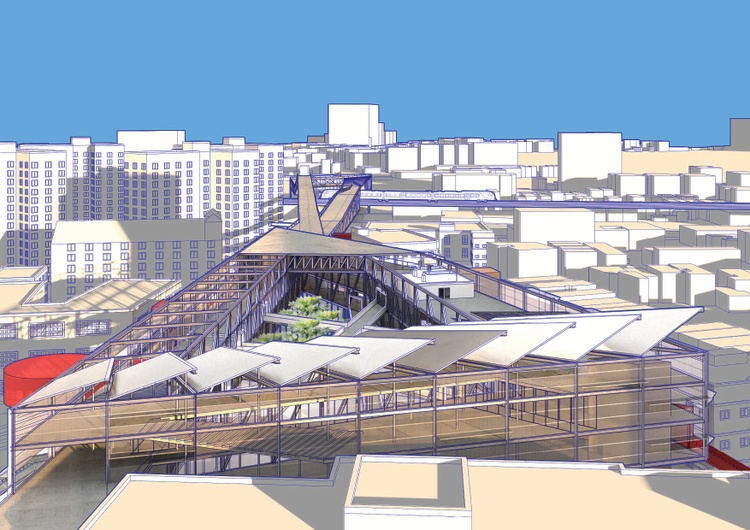The Creative Refine Behind Successful Jobs from CDA Architects
The Creative Refine Behind Successful Jobs from CDA Architects
Blog Article
Comprehending the Collaborative Refine Between Engineers and Designers in Modern Construction Projects
The joint procedure between designers and engineers is vital in contemporary construction tasks, as it balances layout intent with design feasibility. Exploring these characteristics reveals insights that could significantly impact task end results and general industry criteria.
The Relevance of Cooperation
The collective synergy in between designers and engineers is crucial for the effective understanding of any type of construction task. This partnership unites distinctive proficiency and viewpoints, allowing the integration of cutting-edge style with useful engineering remedies. By collaborating, designers and engineers can make certain that a job not only satisfies aesthetic and practical requirements however likewise follows safety and security, sustainability, and budgetary restrictions.
Collaboration promotes a common vision, assisting in the alignment of goals and assumptions from the outset. This positioning is crucial in resolving potential difficulties and mitigating threats that could develop during the job lifecycle. In addition, a collaborative technique enables for the efficient allocation of resources, maximizing both time and price.
The value of partnership reaches the iterative process of design and building, where responses from designers can educate building decisions, leading to more possible and lasting layouts. Alternatively, architects can inspire engineers to think creatively regarding exactly how to accomplish structural stability without jeopardizing creative intent. Eventually, the joint partnership in between engineers and designers is not just valuable; it is basic to the production of high-quality, functional, and innovative built environments that meet the requirements of culture.
Interaction Strategies and Devices
Efficient communication techniques and devices are essential for cultivating partnership between designers and designers throughout the job lifecycle. Establishing clear channels of interaction is crucial to make certain that all staff member are lined up with project objectives, timelines, and responsibilities. Routine conferences, both in-person and digital, give possibilities for stakeholders to go over progression, address concerns, and make educated decisions.
:max_bytes(150000):strip_icc()/Buildingdesigns-GettyImages-912482942-db55b3af711044a3a42ad1040c6711a9.jpg)
Furthermore, taking on collaborative communication devices, such as Slack or Microsoft Teams, allows for instantaneous messaging, file sharing, and recurring discussions, advertising an extra nimble feedback to emerging problems. Paper management systems likewise play an important duty in organizing job documents, ensuring that all staff member have accessibility to the current details.
Shared Goals and Job Vision
A linked project vision serves as the structure for effective collaboration between designers and designers (cda architects). This common vision not only aligns the efforts of both celebrations yet additionally establishes a common framework for decision-making throughout the job's lifecycle. By verbalizing clear goals, stakeholders can successfully browse the intricacies of contemporary building and construction tasks, ensuring that both aesthetic and functional requirements are met
Developing shared goals includes open discussion and a thorough understanding of each discipline's contributions. Architects generally focus on style intent, spatial connections, and individual experience, while engineers emphasize structural honesty, systems capability, and conformity with laws. When these viewpoints are straightened, the outcome is a cohesive job that complies with both creative aspirations and technological usefulness.
In addition, a distinct job vision promotes accountability among group participants, urging each individual to take ownership of their role in attaining the wanted end result. Routine check-ins and collaborative workshops can even more reinforce this dedication, enabling for modifications to be made as the project imp source progresses. Eventually, a common vision not just enhances synergy however also boosts the top quality of the final deliverable, leading to effective project conclusion.
The Role of Modern Technology
Leveraging technology has actually ended up being essential in boosting collaboration in between architects and designers. The integration of innovative software application devices helps with real-time interaction and information sharing, allowing groups to work a lot more efficiently and successfully. Building Info Modeling (BIM) attracts attention as a critical modern technology, allowing both engineers and engineers to produce detailed 3D designs that envelop layout intent and structural integrity. This common graph decreases misunderstandings and enhances the decision-making process.
Furthermore, cloud-based platforms enable seamless collaboration, permitting task stakeholders to accessibility and upgrade job information from anywhere. This promotes a culture of transparency and responsibility, as modifications can be tracked and evaluated in real-time. Additionally, mobile applications further boost interaction, supplying on-site teams with immediate accessibility to task specs and updates.
Emerging technologies such as artificial knowledge and machine learning are additionally starting to contribute in predictive evaluation, assisting groups determine prospective concerns prior to they develop. Ultimately, the role of modern technology in architecture-engineering partnership not just enhances operations performances however also improves innovation, bring about more successful job outcomes. By welcoming these technological innovations, designers and designers can ensure a much more natural and efficient collaborative process throughout the construction lifecycle.
Instance Research Studies in Successful Partnerships
Countless situation researches show the extensive effect of effective collaborations between designers and engineers on project results. One notable example is the cooperation on the High Line in New York City, where landscape designers, designers, and urban coordinators interacted to change an abandoned rail line right into a vivid public park. This multidisciplinary method not just boosted the aesthetic quality however additionally ensured structural security and ecological sustainability.

The Burj Khalifa in Dubai even more demonstrates the click for source significance of collaborative initiatives - cda architects. The assimilation of style and design expertise allowed the project team to accomplish unmatched elevations while sticking to safety laws and visual vision
These examples underscore the importance of communication, depend on, and shared goals. In best site today's complex construction setting, such partnerships are necessary to navigating obstacles and providing projects that fulfill both practical and visionary goals.
Verdict
In conclusion, the partnership between designers and designers is vital for the success of modern building projects. Reliable communication methods, a shared job vision, and the integration of sophisticated modern technologies are vital parts that facilitate this collaboration.
Report this page